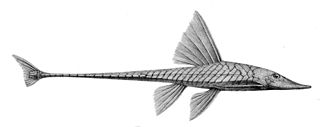
Ancistrus is a genus of nocturnal freshwater fish in the family Loricariidae of order Siluriformes, native to freshwater habitats in South America and Panama. Fish of this genus are common in the aquarium trade where they are known as bushynose or bristlenose catfish. In the aquarium hobby they are often referred to as bushynose or bristlenose plecos instead, but this may lead to confusion as "pleco" usually is used for Hypostomus plecostomus and its allies and is often used as a catchall term for any loricariids remotely resembling that species.

Carl Henry Eigenmann was a German-American ichthyologist of the late nineteenth and early twentieth centuries, who, along with his wife Rosa Smith Eigenmann, and his zoology students is credited with identifying and describing for the first time 195 genera containing nearly 600 species of fishes of North America and South America. Especially notable among his published papers are his studies of the freshwater fishes of South America, the evolution and systematics of South American fishes, and for his analysis of degenerative evolution based on his studies of blind cave fishes found in parts of North America and in Cuba. His most notable works are The American Characidae (1917–1929) and A revision of the South American Nematognathi or cat-fishes (1890), in addition to numerous published papers such as "Cave Vertebrates of North America, a study of degenerative evolution" (1909) and "The fresh-water fishes of Patagonia and an examination of the Archiplata-Archelenis theory" (1909).

Symbolophorus is a genus of lanternfishes. It feeds on various small forms of sea life, in particular fish. Some species in this genus are known to exhibit the Stylophthalmine trait in their larval form

Ceratoscopelus is a genus of lanternfish.

Farlowella is a genus of fish in the family Loricariidae native to South America. This genus is broadly distributed in Amazon, Orinoco, Paraná and coastal rivers of the Guyana Shield. It is absent from the Pacific slope of the Andes and from the coastal rivers of the Brazilian Shield. Many of these species are kept in aquariums. This genus has a unique body shape that resembles a thin stick of wood. The body is slender and elongate, often with a pronounced rostrum and a brownish color with two lateral dark stripes beginning at the tip of the rostrum, passing over the eyes and ending at the tail, which are periodically interrupted on the caudal peduncle.
Oxyropsis is a genus of fish in the family Loricariidae native to South America. These species are distinguished by the presence of a single row of enlarged odontodes along the trunk midline lying adjacent and immediately dorsal to, the lateral line canal. Species of this genus have a depressed head and have relatively large eyes placed ventrolaterally. This genus is most similar to Hypoptopoma in external appearance, which shares the head shape and eye placement. Oxyropsis are elongate and have a narrow caudal peduncle, which distinguishes it from all other Hypoptopomatinae genera except Niobichthys and Acestridium.
Hisonotus is a genus of armored catfishes native to South America. Species of Hisonotus and Curculionichthys are the only representatives of the subfamily Otothyrinae having serrae on the posterior edge of the pectoral fin spine. These species are small fishes, generally found in small fast flowing streams, where they grasp to the branches and leaves of aquatic or subaquatic plants. The species of this genus mostly occur in Atlantic coastal streams of southern Brazil and the Paraguay-Paraná system of southern South America. They are also distributed in the Río de La Plata basin and coastal rivers of southeastern Brazil.
Microlepidogaster is a genus of armored catfishes native to South America.

Sturisoma is a genus of armored catfishes native to Central and South America.

Loricaria is a genus of armored catfish native to South America.

Pimelodella is a genus of three-barbeled catfishes.

Chaetostoma, also known as the bristlemouth catfish, is a genus of suckermouth armored catfishes native to South America with one species, C. fischeri, extending into Panama. Most species inhabit flowing rivers in the lower Andes and its foothills. Some species are kept in unheated aquaria.

Phenacogaster is a genus of characins from South America, with 20 currently described species:

Curimata is a genus of toothless characins from tropical South America, with 13 currently described species:

Cyphocharax is a genus of fish in the family Curimatidae native to South America.
Psectrogaster is a genus of toothless characins from South America, with these currently described species:
Steindachnerina is a genus of toothless characins from South America, with 24 currently described species:

Pyrrhulina is a genus of freshwater fishes found in tropical South America. Several of these species are popular aquarium fish.
Nemuroglanis is a genus of three-barbeled catfishes. With the exception of N. panamensis from Panama, they are native to tropical South America.
'Pseudancistrus' megacephalus is a species of catfish in the family Loricariidae. It is of uncertain and disputed classification.












